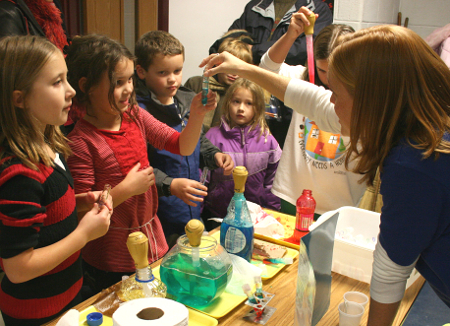On November 1st 2014 I was fortunate enough to
attend Rhode Island College’s 17th Annual Promising Practices;
Culturally Responsive Curricula in STEM.
At first I admit I was not exactly thrilled to attend this conference
bright and early on a Saturday morning and I was a bit nervous this would be
workshops that were not that interesting.
The two workshops that I attended were Girls Gone Wired and Creating
Bully Free Classrooms. I chose both of
these workshops because I felt that they would help in my journey of becoming a
youth worker.

My first
workshop that I attended was Girls Gone Wired; Encouraging Computer Programming
Exploration in Young Women.
The
instructor for this workshop was Hannah Tessitore who is the owner of
SplatypusWeb Design Studio. In this workshop she
discussed about her journey in the world or programming and how it began at a
young age.
Hannah Tessitore main goal in
life is to encourage women into the technology field.
She began her discussion with reminiscing on
her childhood and how she noticed that everything in her house had parts that
were made that item work.
Her home had a
computer in it and during her high school career she would make websites for
her friends who had created their own bands.
She really enjoyed working with technology and being able to find out
how certain things worked.
The idea of
critical thinking and the skills involved with it are key when it comes to
technology and how to create certain things.
Tessitore then began discussing how being a women in the field of
technology comes with many different aspects.
These include a demanding atmosphere, sexual harassment and having very
few women in the field.
She told us how
more women over the past few years have joined the computer science field, but
there is male culture dominance.
When
talking about her company she states that “Customers feel that males would
understand business concepts more”, more male customers just assume that
because she is a female that she cannot understand or have the answer to the
question.
She discusses how a male
versus a female is expected to dress in this field.
With a male they are able to wear a casual
outfit, jeans, button down, sweater, etc.
With a female they are expected to wear business attire, a dress, skirt,
nice shirt, dress shoes, etc.
The idea
of aggression is present when it comes to the male and female roles in this
field.
Tessitore tells us how she felt
that she could not be herself in this field and how it was overly
aggressive.
She then discussed how toys
are being gender based, such as making tinker toys pink that way a little girl
would want to play with them, simply because the color is “girly”.
Legos is another brand that was discussed and
how there are gender neutral Legos and then there are Legos for girls.
The gender neutral are for building and
engineering whereas the girl ones are for “social play”, meaning they can play
with friends and they are only made with one room to build.
She discussed with us the “imposter syndrome”
which is the fear of always being behind, the “oh I’m not qualified”
feeling.
She supports humanizing;
creating a program that speaks to the person not as a female, and not as a
techie, simply speaking to them as a human.
She spoke about equalizing and creating a community or teams were
everyone wins.
She ended her lecture
with saying that “it all begins with taking apart your home”.
I really enjoyed this workshop and the
concepts that were discussed.
I am a
huge fan of media and building something through technology and hearing Hannah
Tessitore give her personal experiences helped to better understand the hidden
facts of girls inside of computer programming.


My second
workshop that I attended was Creating Bully Free Classrooms.
The instructor of this workshop was Elizabeth
Rowell who is from Rhode Island College.
In this workshop Rowell discussed how in the U.S. and other countries
show that children from the ages of three to eight years old are involved in hurtful
bullying that can escalate through the years.
She showed us a slide show about bullying.
Bullying can include more than one thing,
students can be picked on their appearance, their disability, gender related,
family structure or schoolwork.
Bullying
is based on looking, dressing or acting differently.
Bullying is becoming a growing national
health and life problem.
It creates a
hostile and fearful school environment.
Rowell continues to discuss how bullying creates problems for the
students such as psychological scars, anxiety and depression.
Because of the running late of the time it
was difficult really get much done in this workshop.
She passed out papers that talked about the
background information on Antibias/Anitbullying Education for young
children.
She also gave us poems to read
about bullying some of which were named “Remember Me?” along with “My Walk to
School”.
Overall this workshop was very
interesting and a lot of the facts that were presented were new to me.
Bullying is never an option and no one should
have to feel that they are different from everyone else.
Elizabeth Rowell was a great speaker and had
a very interesting workshop planned for us, even though we did not get to do
everything, we got to read the poems together.

After both
of the workshop we returned to Donovan where we were to listen to our keynote
speaker.
The keynote speaker was Chris
Edmin, who is an associate professor in the STEM department at Columbia
University.
Throughout his speech he
discussed how the students and teachers should be able to relate to each
other.
He kept all of the audience
intrigued in what he was saying and never had a dull moment.
The main point that I gathered from this
keynote speaker was that when being in a classroom, as a teacher, it is
beneficial to keep the students involved especially when it is something that
they would like doing.
When you have a
classroom and the students are doing something that they don’t want to really
do they are not going to succeed.
Chris Edmin helped me to open my eyes that children deserve to learn in more than one
way than just the basic sit down classroom where the teacher is talking at them
not were there is a full on teacher to classroom discussion.
These are some of the many things I want to
take throughout my college and youth worker career.
I really enjoyed Promising Practices a lot
more than I thought I would have.
 Quote and Explanation: Another connection, along with Rodriguez,
that I am able to make to my service learning is to August. In “Safe Spaces” by Gerri August’s main focus
is about bullying within the classroom.
August makes a statement saying, “To the extent that teachers, school
administers, and college professors create an atmosphere in which difference is
not only tolerated but expected, explored and embraced, students will be more
likely to develop perspectives that result in respectful behaviors.” (pg 83). This quote discusses how in creating a
certain atmosphere, both teachers and school administers, are able provide a
path to a student’s educational career. I
found that this quote related to my service learning simply because of the
relationship between not only the teacher and the students but with the
students as well. When teaching it is beneficial
to be able to accept the students regardless of how they behave inside of the
classroom around the other students.
Quote and Explanation: Another connection, along with Rodriguez,
that I am able to make to my service learning is to August. In “Safe Spaces” by Gerri August’s main focus
is about bullying within the classroom.
August makes a statement saying, “To the extent that teachers, school
administers, and college professors create an atmosphere in which difference is
not only tolerated but expected, explored and embraced, students will be more
likely to develop perspectives that result in respectful behaviors.” (pg 83). This quote discusses how in creating a
certain atmosphere, both teachers and school administers, are able provide a
path to a student’s educational career. I
found that this quote related to my service learning simply because of the
relationship between not only the teacher and the students but with the
students as well. When teaching it is beneficial
to be able to accept the students regardless of how they behave inside of the
classroom around the other students. So What?: When looking back
at this experience in my service learning I have realized that my teacher
showed August’s concept. If this case
were in any other classroom that I have been in I feel that the teachers would
not handle the situation as well as my teacher did. She calmly accepted the fact that he was
struggling and was able to try and work with him one on one. In a typical classroom this student would be
considered a huge distraction to both the students and the teachers in this
case. I feel that my experience relates
to August because she feels that a student should be able to express him or
herself, sometimes for the worst or the better.
The teacher from my service learning she uses August’s theory, which is
to let the students express themselves in a manor that is acceptable and when
they are struggling she is able to work with them.
So What?: When looking back
at this experience in my service learning I have realized that my teacher
showed August’s concept. If this case
were in any other classroom that I have been in I feel that the teachers would
not handle the situation as well as my teacher did. She calmly accepted the fact that he was
struggling and was able to try and work with him one on one. In a typical classroom this student would be
considered a huge distraction to both the students and the teachers in this
case. I feel that my experience relates
to August because she feels that a student should be able to express him or
herself, sometimes for the worst or the better.
The teacher from my service learning she uses August’s theory, which is
to let the students express themselves in a manor that is acceptable and when
they are struggling she is able to work with them. 







